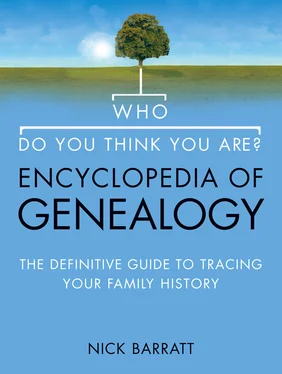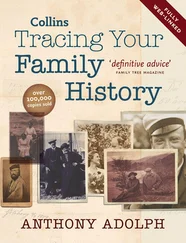1 ...8 9 10 12 13 14 ...38 MyHeritage is a genealogy company that provides free family tree software that you can download from their site. This software allows you to create a family tree on your computer and add photos and documents to it using a simple interface. If you wish, you can then publish your family tree online to share it with family members. The MyHeritage.com homepage also lets you create a free family tree online, without downloading software. This is done in your own family website which you can use for sharing photos, events and news with family members. This approach, often named ‘web 2.0’, is suitable for users who prefer a web-based experience over using a software program. Special genealogy technologies found only on MyHeritage (both the website and the software) include face recognition technology that helps you tag people in photos and recognize unidentified people; and tree-linking technology called Smart Matching that can connect your family tree to more than 1.5 million other trees on MyHeritage. Smart Matching helps you enlarge your family tree and find new relatives and ancestors. Also on MyHeritage.com is an extensive genealogy search engine that searches more than 1,500 online genealogy databases.
Family Search is run by the Church of Jesus Christ of Latter Day Saints, otherwise known as the LDS Church. The Church has been gathering and preserving genealogical records from around the world for over 100 years. You can either upload a GEDCOM file of your family tree from your computer onto their website so that it can be viewed by other researchers when they search the website’s collection of ancestral files, or you can download free Personal Ancestral File (PAF) software from the website and save your tree on your computer as a PAF file. PAF software allows you to enter information about each person’s birth, baptism, marriage, death, notes about the sources you have found, and photographs that can be used to form a scrapbook. You can view your family tree in Family View, which shows you a person’s immediate family, in Pedigree View, which displays the direct line in a diagram working from left to right, or in Individual View, which lists each person in your tree and their birth details.
Having drawn up your family tree, you are ready to begin the next phase of your work – setting your research goals, and then working out which archive or resource you are going to use to achieve those goals. To do this, you must first take a long, hard look at all the information you’ve collected – not just the family tree, but the anecdotes, stories, objects and artefacts – and decide what to tackle first.
… make your family tree
1. If drawing a tree by hand, only use ink when you are sure of a fact, having verified it with official documentation such as a birth, marriage or death certificate
2. Write information you are unsure of in pencil, and leave a question mark against dubious dates or names so that you know further research is required
3. Use your family tree to shape your research plan. Focus on the areas where you want to work further back in time, or are not sure of information you’ve been told
4. Put a date on your family tree each time you revise it, and where possible create a new version each time you’ve discovered something new – either a new file name if you are working online or with a software package, or draw up an amended tree by hand. That way, you can always go back to an earlier version if you’ve made an error
5. Keep a clean master copy of your family tree, but make copies of sections of it to take into the archives with you. That way you can focus on one branch of the family at a time, which will help avoid confusion
6. Once you are more familiar with the practice of compiling your family tree, use a software package to help keep all your notes together. You can add photos, video and audio clips, images of documents and biographical notes to bring the tree to life, depending on the package you have chosen
7. Think about adding your family tree to one of the various online communities that link your data to that of other users. You may find that someone has already done the work for you – though beware of simply accepting non-verified data at face value
Step One: Verify Your Data
Although there are no rights and wrongs, it is strongly advisable to begin by verifying the biographical data you’ve collected through your initial investigation within the family. This will mean ordering duplicate birth, marriage and death certificates where there are gaps in your immediate family tree – if you are not certain of Great-granny Doris’s date of birth, or when your grandparents were married. The good news is that much of this verification process can take place from the comfort of your own home, armed only with a PC and a credit card. As you will find in Section Two, many of the key archive resources (lists of birth, marriages and death, census returns, etc.) are available online; Chapter 4explains how best to use the Internet during these early stages of your research work.
It is vitally important that you know about more traditional ways of finding biographical information, particularly since a large amount will be stored in archives around the country and may not be available online. You will need to learn how to spot important clues from civil registration (birth, marriage and death certificates) documents (for example, that Great-granddad was a soldier when he got married in 1914); to work out whether there are any relevant documents associated with those clues (there are some army service papers for the First World War, 1914–18); establish where the documents are kept (although some documents can be found online, at www.ancestry.co.uk, the bulk are stored at The National Archives); and then visit the institutions in person, which can be a daunting experience if it’s your first time. Consequently Chapter 3goes through each step of this process and describes the different types of archive that are available. (This is essential reading if you are to make the most of the remainder of this book, particularly Section Three where the topics – military connections, immigration and emigration, social history, occupations and family secrets – cover material that is rarely available online.)
Step Two: Working Further Back
Having verified the initial data by using civil registration documents as far back as possible – they go back to 1837 in England and Wales, 1855 in Scotland and 1864 in Ireland – most people decide to follow one line of their family further back in time, looking for new ancestors based on the information they’ve found from these certificates. Once again, the key steps you’ll need to take when tracing an ancestor who was born prior to (say) 1837 are covered in more detail in Section Two, where you’ll start to work with some of the key sources aside from certificates, such as census returns, wills and parish registers. Essentially, this process means that you’ll be adding new branches to your family tree. Although there’s a temptation to jump in and tackle all lines at once, it is usually sensible to focus on one branch at a time, particularly if they have a more unusual surname which will make them easier to trace – you’ll have more success tracking down Jeremiah Sandwick than John Smith, for example. Once you’ve got into the swing of things, you can then speed up your research and look at more than one line at a time.
Читать дальше












